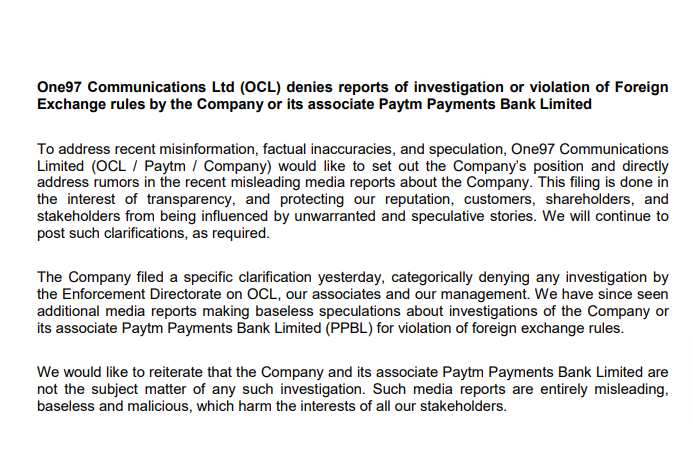-
- Decision trees split the data into branches to predict an outcome, which can be useful for making financial forecasts or evaluating business decisions under uncertainty. They provide a visual representation of decision paths and their possible outcomes.
Conducting a probabilistic analysis on a given text involves assessing the likelihood of certain events or outcomes based on the information provided. This can involve analyzing the tone, content, and specific claims made within the text to estimate probabilities related to the company’s situation, especially concerning investigations or violations of Foreign Exchange rules. Given the nature of this request, let’s break down the text to identify key points and assess their implications probabilistically:
- Denial of Investigations or Violations:
- The text categorically denies any investigations or violations of Foreign Exchange rules by One97 Communications Ltd (OCL) or its associate, Paytm Payments Bank Limited (PPBL). The probabilistic assessment here would focus on the credibility and strength of the denial. Companies often issue strong denials in the face of false or speculative reports. However, the absence of an investigation today does not preclude the possibility of future investigations, depending on regulatory scrutiny and findings.
- Source of Information:
- The text mentions that these clarifications are being made in the interest of transparency and protecting stakeholders from speculative stories. The commitment to transparency might suggest a lower probability of current hidden issues, but it doesn’t eliminate the potential for undiscovered or future concerns.
- Media Reports and Misinformation:
- The document references “misleading media reports” and “baseless speculations.” The presence of misinformation could indicate a higher probability of market confusion or misinterpretation regarding the company’s compliance status. However, the specific impact on the company’s reputation or regulatory scrutiny would depend on the broader context, such as the credibility of the sources of these media reports and the company’s history with compliance issues.
- Impact on Stakeholders:
- The concern expressed for the reputation, customers, shareholders, and stakeholders hints at a recognition of the potential for significant negative impacts from these reports, whether true or not. The proactive denial and clarification can be seen as an attempt to mitigate these impacts, suggesting a strategy to maintain or restore trust.
- Continued Clarifications:
- The promise to continue posting clarifications as required indicates an ongoing effort to manage the narrative and respond to any future allegations or speculations. This could be interpreted as an acknowledgment of the unpredictable nature of such reports and their potential to emerge again.
Probabilistic Analysis Summary:
- Probability of Current Investigations or Violations: Based on the text, the immediate probability seems low, given the strong and specific denials. However, without external verification, the intrinsic probability cannot be precisely determined.
- Probability of Future Investigations or Violations: This remains uncertain and would depend on various factors not discernible from the text alone, including regulatory interest, compliance practices, and the emergence of new information.
- Probability of Misinformation Impacting the Company: High, as acknowledged by the efforts to counteract misleading reports. The company’s proactive communication strategy suggests a high awareness of the potential damage from misinformation.
It’s important to note that probabilistic analysis based on a text like this is inherently speculative and would benefit from additional data, including company history, regulatory environment, and external verification of claims.
